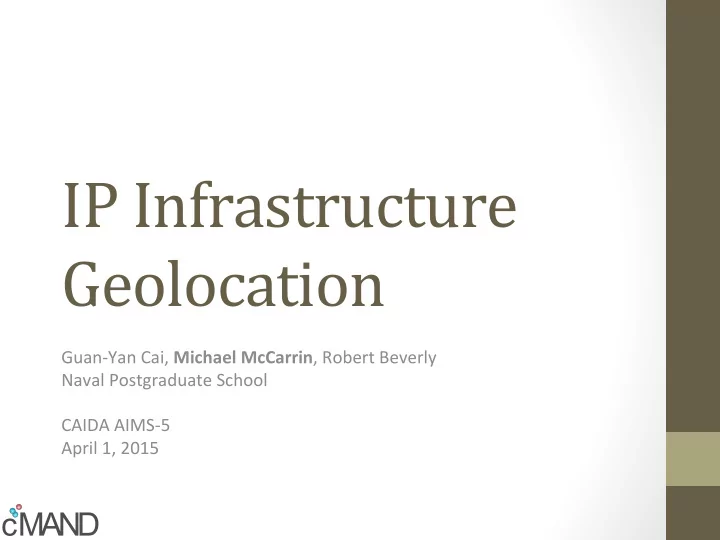

IP ¡Infrastructure ¡ Geolocation ¡ Guan-‑Yan ¡Cai, ¡ Michael ¡McCarrin , ¡Robert ¡Beverly ¡ Naval ¡Postgraduate ¡School ¡ ¡ CAIDA ¡AIMS-‑5 ¡ April ¡1, ¡2015 ¡
Introduction ¡ • IP ¡GeolocaFon: ¡ • Given ¡IP ¡address, ¡determine ¡physical ¡locaFon ¡ • IP ¡GeolocaFon ¡(commercially) ¡used ¡for: ¡ • Targeted ¡adverFsing, ¡recommendaFon ¡systems ¡ • ReputaFon, ¡security ¡ • Hence, ¡majority ¡of ¡exisFng ¡work ¡focuses ¡on ¡edge ¡devices ¡ • Less ¡aSenFon ¡on ¡infrastructure. ¡e.g.,: ¡ ¡ • Routers ¡ • Servers ¡ • MoFvaFon: ¡ • Understand ¡physical ¡Internet ¡topology ¡beSer ¡ 2 ¡
Prior ¡Work ¡ • Prior ¡work ¡on ¡router ¡geolocaFon: ¡ • DNS ¡(undns, ¡DRoP) ¡ • Latency ¡(Yoshida) ¡ • Topology ¡(Feldman) ¡ • State-‑of-‑the-‑art ¡technique: ¡ DNS-‑based ¡Router ¡Posi2oning ¡ (DRoP) ¡by ¡Huffaker ¡et ¡al. ¡ • Relies ¡on ¡geolocaFon ¡clues ¡within ¡DNS ¡PTR ¡record ¡of ¡router’s ¡IP ¡ Use ¡geolocaFon ¡hints ¡to ¡generate ¡rule ¡sets ¡ • Our ¡focus: ¡ • Does ¡not ¡work ¡for ¡routers ¡with ¡no ¡DNS ¡PTRs ¡(40.4% ¡or ¡12.8M) ¡ 3 ¡
Intuition ¡ • Our ¡simple ¡intuiFon: ¡ • Routers ¡are ¡frequently ¡co-‑located ¡with ¡other ¡routers ¡ • E.g., ¡carrier ¡neutral ¡colo, ¡hosFng ¡facility, ¡etc ¡ • Hence, ¡if ¡we ¡can ¡determine ¡that ¡a ¡router ¡with ¡known ¡locaFon ¡ is ¡co-‑located ¡or ¡near ¡to ¡a ¡router ¡with ¡unknown ¡locaFon: ¡ • Provides ¡a ¡means ¡to ¡esFmate ¡(with ¡a ¡measurable ¡upper ¡bound) ¡ the ¡locaFon ¡of ¡unknown ¡router ¡IPs ¡ 4 ¡
Methodology ¡ • Leverage ¡“Street-‑Level ¡geolocaFon” ¡technique ¡(Wang ¡et ¡al. ¡ 2006): ¡ • Uses ¡trace ¡route ¡to ¡esFmate ¡latency ¡between ¡passive ¡landmarks ¡ and ¡target ¡ • This ¡gets ¡you ¡more ¡vantage ¡points ¡(via ¡passive ¡landmarks) ¡ • Accuracy ¡is ¡proporFonal ¡to ¡number ¡of ¡vantage ¡points ¡and ¡nearest ¡ vantage ¡point ¡ • Apply ¡Wang’s ¡technique ¡to ¡router ¡interfaces: ¡ • Router ¡interfaces ¡(instead ¡of ¡web ¡servers) ¡as ¡landmarks ¡ 5 ¡
Methodology ¡ • GeolocaFng* ¡target, ¡ T , ¡with ¡landmarks, ¡ L i : ¡ • Perform ¡traceroutes ¡to ¡ T ¡and ¡to ¡ L i ¡ 6 ¡ * ¡Technique ¡adapted ¡from ¡Street-‑Level ¡geolocaFon ¡by ¡Wang ¡et ¡al. ¡
Methodology ¡ • GeolocaFng ¡target, ¡ T , ¡with ¡landmarks, ¡ L i : ¡ • Perform ¡trace ¡routes ¡to ¡ T ¡and ¡to ¡ L i ¡ • Determine ¡point ¡at ¡which ¡traceroutes ¡diverge ¡(F) ¡ • EsFmate ¡landmark ¡to ¡target ¡delay, ¡D, ¡for ¡all ¡< L i ¡ , ¡ T > ¡ ≤ As ¡we ¡have ¡no ¡control ¡ over ¡landmarks, ¡we ¡ 7 ¡ esFmate ¡delay ¡between ¡ the ¡landmark ¡and ¡target ¡ with ¡ d 1 ¡ + ¡ d 2 ¡
Methodology ¡ • GeolocaFng ¡target, ¡ T , ¡with ¡landmarks, ¡ L i : ¡ • Perform ¡trace ¡routes ¡to ¡ T ¡and ¡to ¡ L i ¡ • EsFmate ¡delay ¡(milliseconds), ¡D, ¡for ¡all ¡< L i ¡ , ¡ T > ¡ • Find ¡ L min ¡that ¡produces ¡the ¡least ¡esFmated ¡delay ¡for ¡all ¡< L i ¡ , ¡ T > ¡ over ¡all ¡vantage ¡points ¡ • Note, ¡esFmated ¡delay ¡is ¡an ¡upper ¡bound ¡(worst ¡case) ¡ • LocaFon ¡of ¡T ¡= ¡LocaFon ¡of ¡ L min ¡ L 4 ¡is ¡nearest ¡to ¡ T , ¡so ¡ T ’s ¡locaFon ¡is ¡ ¡ approximated ¡as ¡ L 4 ’s ¡locaFon. ¡ 8 ¡
Experiment ¡ • Use ¡DRoP ¡results ¡as ¡ground ¡truth ¡ • From ¡DRoP’s ¡~6M ¡interfaces ¡and ¡~8K ¡unique ¡locaFons: ¡ • Find ¡locaFons ¡with ¡two ¡interfaces ¡that ¡respond ¡to ¡trace ¡route ¡ without ¡anonymous ¡hops ¡(about ¡half) ¡ • Half ¡of ¡them ¡as ¡landmarks ¡(~4K) ¡ • Half ¡of ¡them ¡as ¡targets ¡(~4K) ¡ • Applied ¡our ¡methodology ¡to ¡geolocate ¡all ¡4K ¡targets ¡ • Calculated ¡ Error ¡Distance ¡(km) ¡i.e., ¡geolocated ¡posiFon ¡versus ¡ DRoP’s ¡locaFon ¡(Haversine ¡distance) ¡ Target’s ¡geoloca5on ¡ Target’s ¡ground ¡truth ¡loca5on ¡ Error ¡Distance ¡(km) ¡ • Nearest ¡landmark ¡ • LocaFon ¡obtained ¡from ¡ • LocaFon ¡obtained ¡from ¡ ¡ DRoP ¡results ¡ 9 ¡ DRoP ¡results ¡
Results ¡– ¡Global ¡Err. ¡Dist. ¡ CDF*for*Error*Dist.*of*4,152*GeolocaEons*on*DRoP*Feb*'15*Results* 1.0# 0.9# 0.8# 0.7# • 50% ¡of ¡geo ¡predicFons ¡have ¡an ¡ 0.6# error ¡distance ¡> ¡~2,000km! ¡ Probability* • Not ¡accurate ¡ L ¡ 0.5# 0.4# 0.3# 0.2# 0.1# 10 ¡ 0.0# 0# 2,000# 4,000# 6,000# 8,000# 10,000# 12,000# 14,000# 16,000# 18,000# 20,000# 22,000# Error*distance*between*geolocated*result*and*DRoP*ground*truth*(km)*
Results ¡– ¡Err. ¡Dist. ¡from ¡different ¡ Vantage ¡Points ¡ CDF*for*Error*Dist.*of*Geoloca@ons*from*6*Con@nents* 1.0# 0.9# 0.8# 0.7# 0.6# SAN# Probability* CBG# Choice ¡of ¡vantage ¡points ¡ ¡ 0.5# MEL# appears ¡to ¡be ¡ not ¡important ¡ SIN# 0.4# SAO# PRY# 0.3# 0.2# 11 ¡ 0.1# 0.0# 0# 2,000# 4,000# 6,000# 8,000# 10,000# 12,000# 14,000# 16,000# 18,000# 20,000# 22,000# Error*distance*between*geolocated*result*and*DRoP*ground*truth*(km)*
Results ¡– ¡Est. ¡Delay ¡from ¡nearest ¡ landmark ¡(multiple ¡VPs) ¡ CDF*for*Est.*Delay*of*Geoloca-ons*from*6*Con-nents* 1.0# • However, ¡examining ¡the ¡ 0.9# distribuFon ¡of ¡delays ¡ from ¡target ¡to ¡landmark ¡ 0.8# • We ¡do ¡pick ¡nearby ¡ 0.7# landmarks ¡ J ¡ 0.6# SAN# Probability* CBG# 0.5# MEL# SIN# 0.4# SAO# Q: ¡Are ¡discrepancies ¡between ¡ PRY# 0.3# the ¡two ¡CDFs ¡caused ¡by ¡ 0.2# inaccuracies ¡in ¡DRoP? ¡ (which ¡we ¡assumed ¡as ¡ground ¡ 12 ¡ 0.1# truth) ¡ 0.0# 0.01# 0.1# 1# 10# 100# 1000# 10000# Es-mated*Delay*between*Landmark*and*Target*( log 10 *ms)*
Evaluating ¡DRoP ¡ • Given ¡our ¡findings, ¡we ¡sought ¡to ¡beSer ¡understand ¡DRoP ¡ data: ¡ • Examine ¡locaFon ¡inconsistencies ¡ • Use ¡CBG ¡to ¡determine ¡if ¡locaFons ¡are ¡feasible ¡ • Use ¡CBG ¡to ¡determine ¡self-‑consistency ¡of ¡IPs ¡believed ¡to ¡be ¡at ¡a ¡ parFcular ¡locaFon ¡ 13 ¡
Errors ¡in ¡DRoP ¡Locations ¡ • How ¡can ¡there ¡be ¡errors ¡in ¡locaFons? ¡ • E.g. ¡ • 251|us|ca|san francisco|36.3480163544573|-106.644463571429 • Where ¡is ¡that ¡lat/long? ¡ 14 ¡
Recommend
More recommend